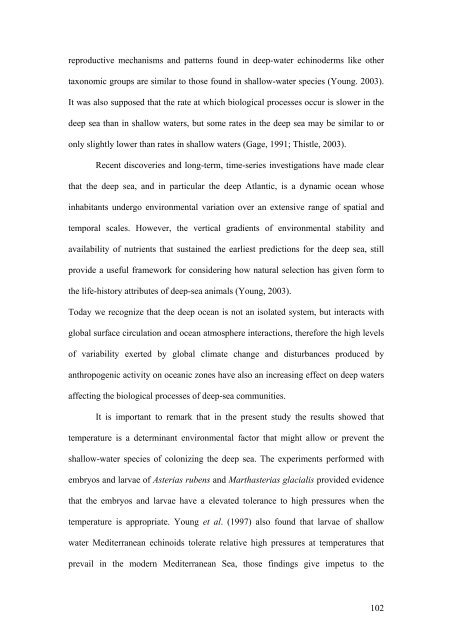Download (3398Kb) - ePrints Soton - University of Southampton
Download (3398Kb) - ePrints Soton - University of Southampton
Download (3398Kb) - ePrints Soton - University of Southampton
You also want an ePaper? Increase the reach of your titles
YUMPU automatically turns print PDFs into web optimized ePapers that Google loves.
eproductive mechanisms and patterns found in deep-water echinoderms like other<br />
taxonomic groups are similar to those found in shallow-water species (Young. 2003).<br />
It was also supposed that the rate at which biological processes occur is slower in the<br />
deep sea than in shallow waters, but some rates in the deep sea may be similar to or<br />
only slightly lower than rates in shallow waters (Gage, 1991; Thistle, 2003).<br />
Recent discoveries and long-term, time-series investigations have made clear<br />
that the deep sea, and in particular the deep Atlantic, is a dynamic ocean whose<br />
inhabitants undergo environmental variation over an extensive range <strong>of</strong> spatial and<br />
temporal scales. However, the vertical gradients <strong>of</strong> environmental stability and<br />
availability <strong>of</strong> nutrients that sustained the earliest predictions for the deep sea, still<br />
provide a useful framework for considering how natural selection has given form to<br />
the life-history attributes <strong>of</strong> deep-sea animals (Young, 2003).<br />
Today we recognize that the deep ocean is not an isolated system, but interacts with<br />
global surface circulation and ocean atmosphere interactions, therefore the high levels<br />
<strong>of</strong> variability exerted by global climate change and disturbances produced by<br />
anthropogenic activity on oceanic zones have also an increasing effect on deep waters<br />
affecting the biological processes <strong>of</strong> deep-sea communities.<br />
It is important to remark that in the present study the results showed that<br />
temperature is a determinant environmental factor that might allow or prevent the<br />
shallow-water species <strong>of</strong> colonizing the deep sea. The experiments performed with<br />
embryos and larvae <strong>of</strong> Asterias rubens and Marthasterias glacialis provided evidence<br />
that the embryos and larvae have a elevated tolerance to high pressures when the<br />
temperature is appropriate. Young et al. (1997) also found that larvae <strong>of</strong> shallow<br />
water Mediterranean echinoids tolerate relative high pressures at temperatures that<br />
prevail in the modern Mediterranean Sea, those findings give impetus to the<br />
102
















